Highlights of QB3-Berkeley research, awards, and events news from 2018
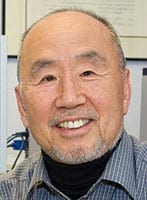 November 28, 2018 – Sung-Hou Kim Elected AAAS Fellow
November 28, 2018 – Sung-Hou Kim Elected AAAS Fellow
Sung-Hou Kim, a professor of the graduate school in the Department of Chemistry and Berkeley Lab scientist, has been elected fellows of the American Association for the Advancement of Science, the nation’s largest scientific organization. Kim, a structural biologist, was recognized “for a landmark discovery of the structures of t-RNA, H-Ras and B-Raf, and for the mapping of the protein structure and genome sequence universes.” He is currently focused on understanding the diversity of protein structures and what that tells us about evolution. More >
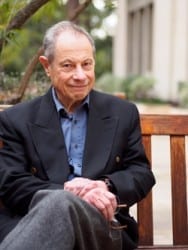 November 26, 2018 – Jack Kirsch Dies at 84
November 26, 2018 – Jack Kirsch Dies at 84
Jack Kirsch, esteemed scientist, mentor, and family man, died November 12. He served as a Professor of MCB and Chemistry from 1964 to 2006 and as a Professor of the Graduate School in retirement. In 2016 he received the UC Berkeley Edward A. Dickson Emeriti Professorship, a prestigious award that epitomized Jack’s remarkable impact, from his ground-breaking research in biochemistry to his passion for teaching a freshman seminar titled “Sampling the Performing Arts at Berkeley.” More >
 November 16, 2018 – Freeze-frame Microscopy Captures Molecule’s ‘Lock-and-Load’ on DNA
November 16, 2018 – Freeze-frame Microscopy Captures Molecule’s ‘Lock-and-Load’ on DNA
Pushing the limits of cryo-electron microscopy, Eva Nogales and her colleagues have captured freeze-frames of the changing shape of a huge molecule, one of the body’s key molecular machines, as it locks onto DNA and loads the machinery for reading the genetic code. The new, more detailed snapshots of the molecule’s moving parts could help drug designers create drugs that interfere with the molecule’s structural changes in order to tweak the expression of a gene that is causing disease. More >
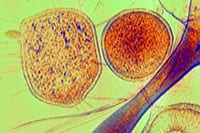 October 18, 2018 – Smallest Life Forms Have Smallest Working CRISPR System
October 18, 2018 – Smallest Life Forms Have Smallest Working CRISPR System
Researchers have found that an ancient group of microbes that contains some of the smallest life forms on Earth also has the smallest CRISPR gene-editing machinery discovered to date. The tiny protein machinery, dubbed Cas14, is related to but one-third the size of the Cas9 protein, the business end of the revolutionary gene-editing tool CRISPR-Cas9. The discovery paves the way for further investigations of other CRISPR systems. More >
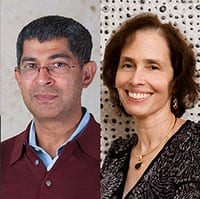 October 17, 2018 – Kuriyan and Meyer Elected to National Academy of Medicine
October 17, 2018 – Kuriyan and Meyer Elected to National Academy of Medicine
John Kuriyan, professor of molecular and cell biology and of chemistry, and Barbara Meyer, professor of molecular and cell biology and a Howard Hughes Medical Institute investigator, have been elected to the National Academy of Medicine, considered one of the highest honors in health and medicine. Membership in the academy recognizes individuals who have demonstrated outstanding professional achievement and commitment to service. Kuriyan was cited for pioneering contributions to understanding the regulation of cell signaling and for determining the structure and the molecular origin of the precision medicine drug Gleevec. Meyer was honored for groundbreaking work on chromosome dynamics. More >
 October 15, 2018 – New Test Rapidly Identifies Antibiotic-resistant ‘Superbugs’
October 15, 2018 – New Test Rapidly Identifies Antibiotic-resistant ‘Superbugs’
When you get sick, you want the right treatment fast. But certain infectious microbes are experts at evading the very anti-bacterial drugs designed to fight them. A simple and inexpensive new test developed by Niren Murthy, Lee Riley, and their colleagues can diagnose patients with antibiotic-resistant strains of bacteria in a matter of minutes. The technique could help doctors prescribe the right antibiotics for each infection, and could help limit the spread of antibiotic-resistant “superbugs,” which kill as many as 700,000 people worldwide each year. More >
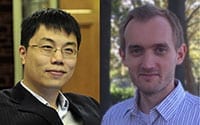 October 2, 2018 – Xu and Titov Receive NIH Director’s New Innovator Awards
October 2, 2018 – Xu and Titov Receive NIH Director’s New Innovator Awards
Ke Xu, assistant professor of Chemistry and a Chan-Zuckerberg Biohub Investigator, and Denis Titov, adjunct professor in the Department of Molecular and Cell Biology, have received NIH Director’s New Innovator Awards, which supports a early stage investigators who propose bold new approaches with the potential to produce a major impact on a broad area of biomedical or behavioral research. Xu’s current research develops new physicochemical tools to interrogate biological, chemical, and materials systems at the nanoscale with extraordinary resolution, sensitivity, and functionality. Titov is interested in understanding how changes in energy metabolism affect aging and age-associated diseases. More >
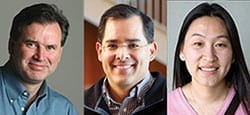 June 27, 2018 – Conolly, Schaffer, and Xu Join the Ranks of the Bakar Fellows
June 27, 2018 – Conolly, Schaffer, and Xu Join the Ranks of the Bakar Fellows
Steven Conolly, David Schaffer, and Ting Xu have been selected for the Bakar Fellows Program, which supports faculty working to apply scientific discoveries to real-world issues in the fields of engineering, computer science, chemistry, and biological and physical sciences. The program gives up to five years of funding to help faculty further develop their innovations and ready them for the market in areas considered likely to stimulate California’s economy. Conolly is working on high-resolution three-dimensional imaging method for cancer treatment. Schaffer’s focus is on gene therapy for rare diseases such as hemophilia. Xu is a materials scientist studying biodegradable plastics. More >
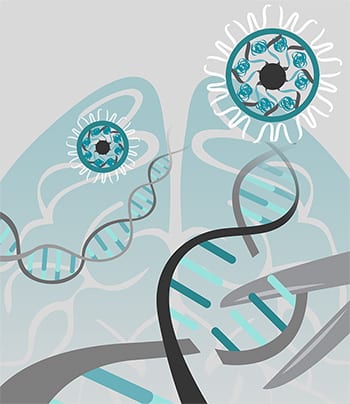 June 25, 2018 – CRISPR Reduces Autism Symptoms in Mice
June 25, 2018 – CRISPR Reduces Autism Symptoms in Mice
Niren Murthy and his colleagues have used CRISPR-Cas9 gene editing to lessen some autism symptoms in mice with a form of fragile X syndrome (FXS), the most common known single-gene cause of autism spectrum disorder. Employing gold nanoparticles to deliver the DNA-cutting Cas9 enzyme into the brain, the researchers were able to edit the gene for a neurotransmitter receptor and reduce the repetitive behavior characteristic of fragile X syndrome. A similar approach could be used to treat the exaggerated repetitive behavior characteristic of other autism spectrum disorders. The new study is the first demonstration that Cas9 protein can be ferried into the brain to knock out a gene and have therapeutic effects. More >
 June 19, 2018 – Doudna-Charpentier Team Awarded U.S. Patent for CRISPR-Cas9
June 19, 2018 – Doudna-Charpentier Team Awarded U.S. Patent for CRISPR-Cas9
The United States Patent and Trademark Office has granted a patent covering the use of CRISPR-Cas9 gene editing with formats useful in developing human therapeutics and improving food security. Patents for the wide use of CRISPR-Cas9 for gene editing all types of cells have already been issued to the Jennifer Doudna-Emmanuelle Charpentier team by the European Patent Office, the United Kingdom, China, Japan, Australia, New Zealand, Mexico and other countries. The new patent issued broadly covers the use of a CRISPR-Cas9 compound that is specially engineered to be more easily employed inside any type of plant or animal cell, or outside a cell, in order to modify a gene or the expression of a gene. More >
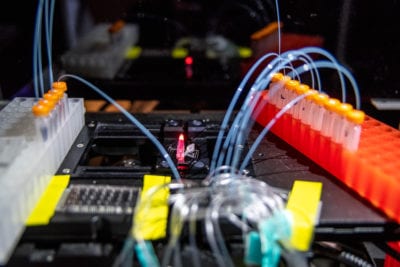 June 18, 2018 – New DNA Synthesis Technique Promises Rapid, High-fidelity DNA Printing
June 18, 2018 – New DNA Synthesis Technique Promises Rapid, High-fidelity DNA Printing
Scientists at the UC Berkeley and Lawrence Berkeley National Laboratory have invented a new way to synthesize DNA that promises to be easier and faster, does not require the use of toxic chemicals and is potentially more accurate. With greater accuracy, the technique could produce DNA strands 10 times longer than today’s methods. The researchers say the ease of use could lead to ubiquitous “DNA printers” in research labs, akin to the 3D printers in many workshops today. More >
 May 31, 2018 – Jennifer Doudna Shares 2018 Kavli Prize in Nanoscience
May 31, 2018 – Jennifer Doudna Shares 2018 Kavli Prize in Nanoscience
The Kavli Prize in Nanoscience was awarded to Jennifer Doudna and two colleagues, Emmanuelle Charpentier and Virginijus Šikšnys, who developed the powerful nanoscale tool CRISPR-Cas9 to edit DNA. According to the Kavli announcement, their “pioneering work has unleashed global interest among scientists and the public in a field of research with enormous potential to address disease-causing mutations in humans and improve agriculture.” More >
 May 10, 2018 – Tau-tally Microtubular!
May 10, 2018 – Tau-tally Microtubular!
Eva Nogales and her colleagues at UC Berkeley and Lawrence Berkeley National Laboratory have combined cutting-edge cryo-electron microscopy (cryo-EM) with computational molecular modeling to produce a near-atomic-resolution model of the interaction between microtubules – crucial components of eukaryotic cell ultrastructure – and microtubule-associated proteins called tau. This research has potential implications for understanding Alzheimer’s disease. More >
 May 1, 2018 – Ehud Isacoff New Member of National Academy of Sciences
May 1, 2018 – Ehud Isacoff New Member of National Academy of Sciences
Ehud Isacoff, a professor of molecular and cell biology and director of the Helen Wills Neuroscience Institute, has been selected as a new member of the National Academy of Sciences. Isacoff, who also directs the Molecular Imaging Center, develops new techniques to manipulate neurons and their synaptic connections to other neurons in order to understand the brain circuits responsible for perception and motor activity. The academy, the most prestigious scientific society in the U.S., provides science, engineering, and health policy advice to the federal government and other organizations. More >
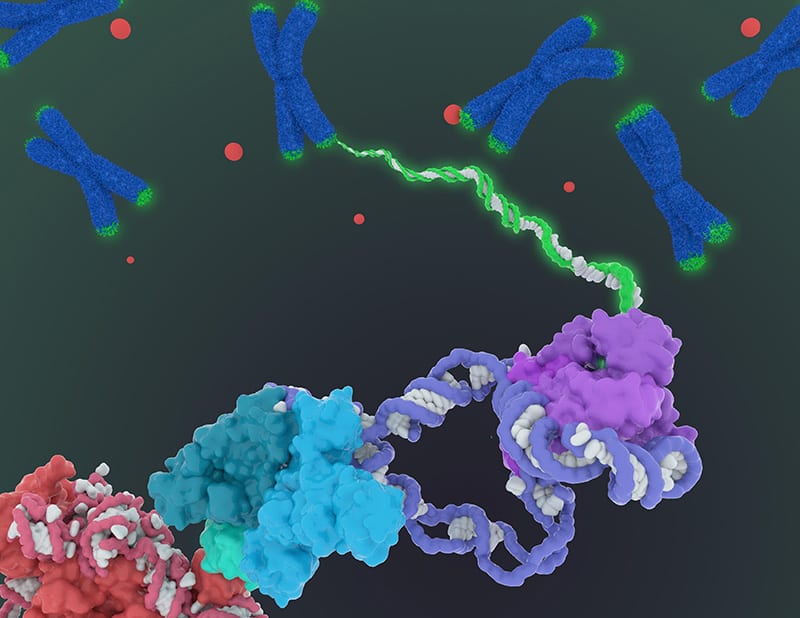 April 25, 2018 – Long-sought Structure of Telomerase Paves Way for Drugs for Aging, Cancer
April 25, 2018 – Long-sought Structure of Telomerase Paves Way for Drugs for Aging, Cancer
More than 30 years ago, when UC Berkeley researchers discovered telomerase — an enzyme that lengthens chromosome ends and prevents them from fraying enough to kill a cell, the discovery set set off a full-court press to produce drugs to activate or block the enzyme. While neither telomerase-based anti-aging drugs nor anticancer drugs have yet appeared, the publication by Kathleen Collins, Eva Nogales, and their colleagues of the first detailed picture of the molecular structure of human telomerase should jump-start that effort, allowing more targeted drug screens and intelligent design of new drugs. More >
 April 20, 2018 – George Oster, Pioneer in Applying Mathematics to Biology, Dies at 77
April 20, 2018 – George Oster, Pioneer in Applying Mathematics to Biology, Dies at 77
George Oster, a professor emeritus of environmental science, policy and management at the UC Berkeley and a pioneer in applying mathematics and physics to understanding biology, in particular biological machines and the shapes of organisms, died April 15 at his home in Berkeley. Oster was part of a great generation of scientists who had the audacity and freedom to move between disciplines. More >
 April 19, 2018 – Enlarged Spleen Key to Diving Endurance of ‘Sea Nomads’
April 19, 2018 – Enlarged Spleen Key to Diving Endurance of ‘Sea Nomads’
Competitive breath-hold divers have only two options to increase their time underwater – through training, they can try to boost their lung capacity or increase their red blood cell count. Over hundreds if not thousands of years, however, a group of Southeast Asian “sea nomads” known for their deep-diving prowess has evolved a better solution which has been revealed by Rasmus Nielsen and his colleagues. The Bajau people have evolved genetically enlarged spleens which allows them to use oxygen more efficiently so they can stay underwater for longer. More >
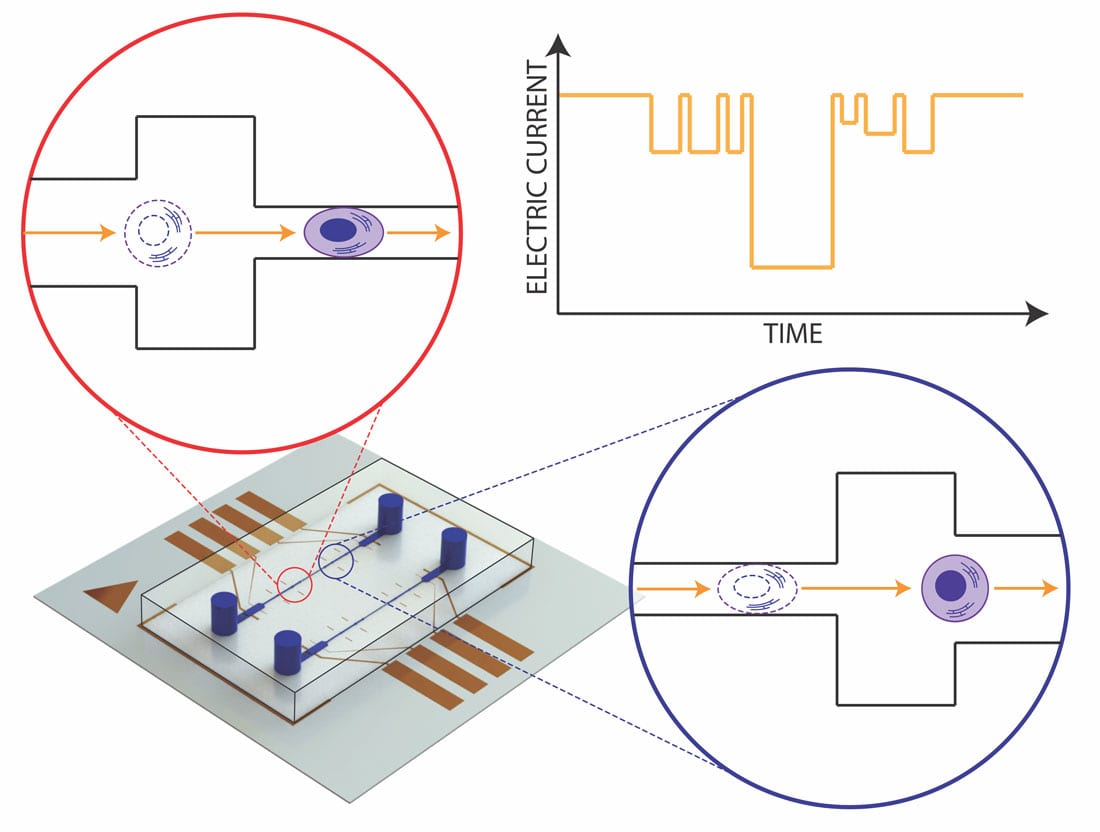 April 17, 2018 – Berkeley Engineers Squeeze Cells Through Microtubes to Detect Cancer
April 17, 2018 – Berkeley Engineers Squeeze Cells Through Microtubes to Detect Cancer
Over the course of her lifetime, a woman has a one in eight chance of developing breast cancer. With the past few decades’ advances in early detection and treatment, a diagnosis by no means forecasts defeat. The earlier the cancer is detected, the more likely bad luck can turn to good. New technology being developed by Lydia Sohn and her research group could dramatically improve the speed and accuracy of early breast cancer detection through the use of microfluidics. More >
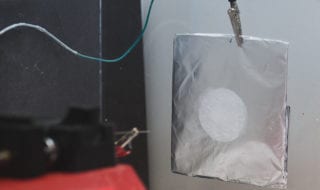 March 15, 2018 – Researchers Create a Protein ‘Mat’ That Can Soak Up Pollution
March 15, 2018 – Researchers Create a Protein ‘Mat’ That Can Soak Up Pollution
In a breakthrough that could lead to a new class of materials with functions found only in living systems, Ting Xu and her colleagues have figured out a way to keep certain proteins active outside of the cell. The researchers used this technology to create mats that can soak up and trap chemical pollution. The new study shows a path toward exploiting the power of proteins outside of the cell by demonstrating a unique way to keep proteins active in synthetic environments. More >
 March 6, 2018 – Brown Fat Flexes Its Muscle to Burn Energy — and Calories
March 6, 2018 – Brown Fat Flexes Its Muscle to Burn Energy — and Calories
Sanjay Kumar and his colleagues have discovered that brown fat cells, which help mammals regulate their body temperature, also work much like muscle cells. These cells, which are the same kind of fat cells that help newborn babies regulate their body temperature, could be a target for weight-loss drugs in adults. The study offers an example of how mechanical and other physical forces can influence physiology and disease in powerful, unexpected ways. More >
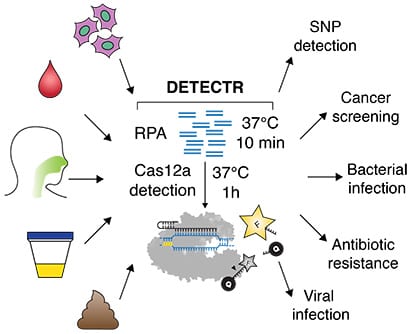 February 15, 2018 – CRISPR Scissors, Cas12a, Enables Cutting-edge Diagnostics
February 15, 2018 – CRISPR Scissors, Cas12a, Enables Cutting-edge Diagnostics
CRISPR-Cas12a, one of the DNA-cutting proteins revolutionizing biology today, has an unexpected side effect that makes it an ideal enzyme for simple, rapid and accurate disease diagnostics. Researchers in the Jennifer Doudna Lab have recently discovered that this protein works as a robust tool to detect DNA from a variety of sources. It is potentially applicable in any point-of-care diagnostic situation where there is a DNA component, including cancer and infectious disease. More >
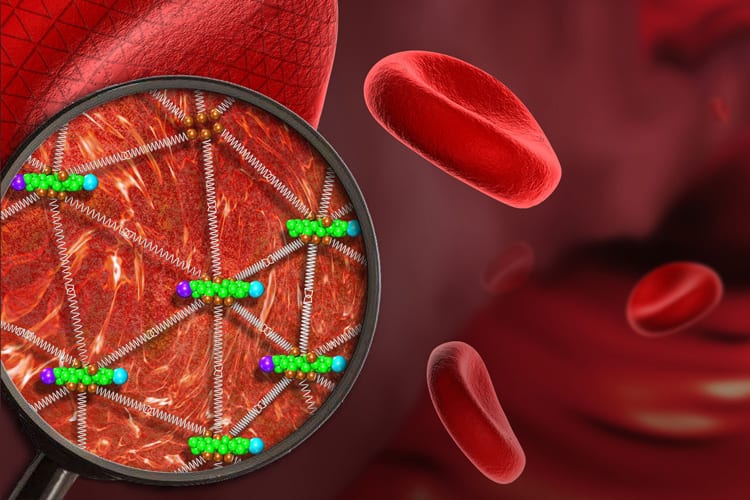 January 30, 2018 – Super-resolution Microscopy Reveals Fine Detail of Cellular Mesh
January 30, 2018 – Super-resolution Microscopy Reveals Fine Detail of Cellular Mesh
Ke Xu and his colleagues, using one of today’s best imaging tools, super-resolution microscopy, have provided a sharp view of the geodesic mesh that supports the outer membrane of a red blood cell, revealing why such cells are sturdy yet flexible enough to squeeze through narrow capillaries as they carry oxygen to our tissues. The discovery could eventually help uncover how the malaria parasite hijacks this mesh, called the sub-membrane cytoskeleton, when it invades and eventually destroys red blood cells. More >
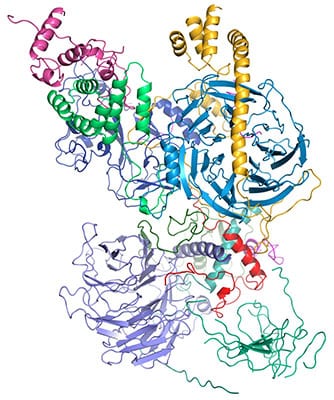 January 29, 2018 – Silencing Is Golden: Scientists Image Molecules Vital for Gene Regulation
January 29, 2018 – Silencing Is Golden: Scientists Image Molecules Vital for Gene Regulation
All the trillions of cells in our body share the same genetic information and are derived from a single, fertilized egg. How can the same genetic blueprint lead to the diversity of various cell types, such as nerve, muscle, or blood cells? The answer lies in the way that genes are switched on or off during the course of development. In two new studies, a team of researchers led by Eva Nogales has gained insight into the structure of a complex of proteins called the Polycomb Repressive Complex 2 (PRC2) and the ways in which it is regulated to affect gene silencing. More >
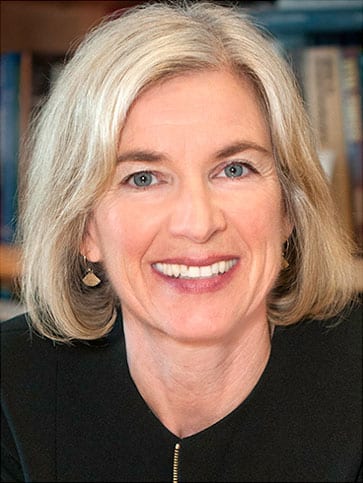 January 17, 2018 – National Academy of Sciences Award for Doudna
January 17, 2018 – National Academy of Sciences Award for Doudna
Jennifer Doudna, a professor of molecular and cell biology and of chemistry, was honored this week by the National Academy of Sciences for her innovative body of research work. Doudna, a Howard Hughes Medical Institute investigator, received the 2018 NAS Award in Chemical Sciences for “pioneering discoveries on how RNA can fold to function in complex ways” and the invention, with Emmanuelle Charpentier, of the CRISPR-Cas9 gene-editing technology. More >
 January 2, 2018 – CRISPR Put to Work to Save Chocolate from Devastation
January 2, 2018 – CRISPR Put to Work to Save Chocolate from Devastation
Chocolate is forever, right? UC Berkeley scientists, using the revolutionary gene-editing tool CRISPR, are working to make it so, as climate change threatens the cacao plant’s favorite growing sites. Jennifer Doudna, the UC Berkeley geneticist who invented CRISPR, is overseeing the collaboration. More >
Faculty Awards and News – 2018
December 11, 2018 – GenEdit Reels in $8.5M to Tackle Delivery for Gene Therapy, Gene Editing
In October last year, a team of UC Berkeley scientists reported a new, nonviral CRISPR-delivery system that might address safety concerns with the gene-editing technology. Now, their company, GenEdit, which is one of QB3-Berkeley’s current Garage teams, has picked up $8.5 million in seed funding to develop their nanoparticle system. More >
 November 6, 2018 – Big Data Approach to Understanding Multiple Sclerosis Treatment
November 6, 2018 – Big Data Approach to Understanding Multiple Sclerosis Treatment
The National Institute of Nursing Research is funding research by Lisa Barcellos into what contributes to clinical outcomes in multiple sclerosis treatment, in partnership with colleagues at Kaiser Permanente Division of Research in Oakland. The team will also develop easy-to-read electronic reports for neurologists designed to enhance patient care in the clinic.
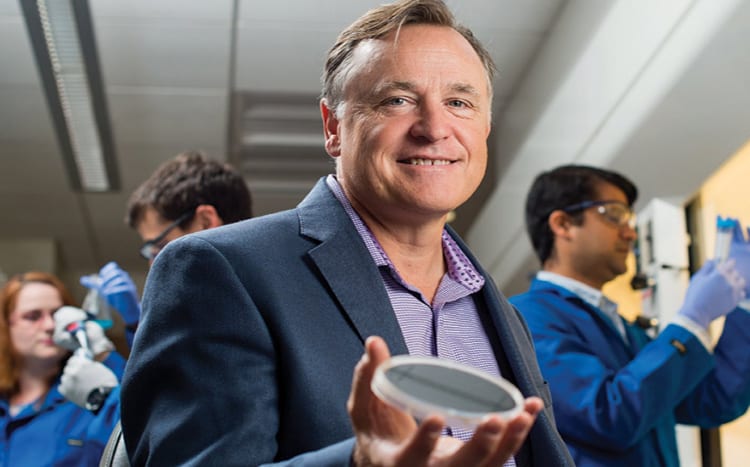 November 1, 2018 – Kevin Healy Named BMES Fellow
November 1, 2018 – Kevin Healy Named BMES Fellow
The Biomedical Engineering Society (BMES) honored Kevin Healy as a new fellow at the BMES annual meeting in Atlanta in October. Fellow status is awarded to members who demonstrate exceptional achievements in the field of biomedical engineering and a record of membership and participation. More >
 October 18, 2018 – Doudna Receives American Cancer Society Award
October 18, 2018 – Doudna Receives American Cancer Society Award
The American Cancer Society bestowed its highest honor, the Medal of Honor, on Jennifer Doudna and four others — including former Vice President Joseph Biden Jr. – during a ceremony Oct. 18 in Washington, D.C. The medal is awarded to distinguished individuals who have made valuable contributions in the fight against cancer through basic research, clinical research and cancer control. More >
 October 12, 2018 – Rachel Haurwitz Honored
October 12, 2018 – Rachel Haurwitz Honored
Berkeley alumna Rachel Haurwitz, President and CEO of Caribou Biosciences, won a 2018 Berkeley Visionary Award, created by the Berkeley Chamber of Commerce to celebrate innovative entrepreneurs based in Berkeley, as they strive to meet the challenges of the 21st century. More >
 October 10, 2018 – Building Career Skills Series
October 10, 2018 – Building Career Skills Series
Free workshops and panel events for doctoral students and postdocs in biosciences launch this fall, sponsored by QB3-Berkeley Graduate and Postdoc Career Development. More >
 July 26, 2018 – Beyene and Landry Receive Gilliam Fellowship
July 26, 2018 – Beyene and Landry Receive Gilliam Fellowship
The Howard Hughes Medical Institute has awarded Gilliam Fellowships for Advanced Study to the doctoral student-adviser pair, Abraham Beyene and Markita Landry, to support the development of their scientific leadership and commitment to advancing diversity and inclusion in the sciences. Each pair will receive an annual award totaling $50,000, which includes a stipend, a training allowance, and an institutional allowance for up to three years. Each fellow’s thesis adviser will participate in a year of mentor development activities. More >
 July 18, 2018 – Markita Landry receives 2018 DARPA Young Faculty Award
July 18, 2018 – Markita Landry receives 2018 DARPA Young Faculty Award
Assistant Professor of Chemical and Biomolecular Engineering Markita Landry has been awarded a prestigious two-year Department Of Defense Advanced Research Projects Agency (DARPA) Young Faculty Award for her project Brain Chemical Signaling: A New Input Signal for Brain-Computer Interfaces. Landry’s research lies at the intersection of single-molecule biophysics and nanomaterial-polymer science to develop new tools to probe and characterize complex biological systems. The DARPA project will focus on using new technology developed in the Landry lab of synthetic near-infrared optical nanosensors to develop a brain-computer interface driven by neurochemistry. More >
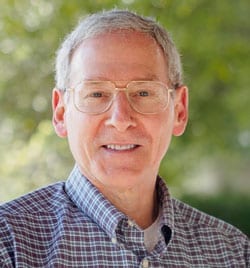 June 28, 2018 – Thorner Receives 2019 ASBMB Herbert Tabor Research Award
June 28, 2018 – Thorner Receives 2019 ASBMB Herbert Tabor Research Award
Jeremy Thorner is the 2019 recipient of ASBMB’s Herbert Tabor Research Award. This award recognizes scientists who have made outstanding contributions in biochemistry and molecular biology. Thorner will receive a $30,000 research award, a plaque, and present a lecture on his research at ASBMB’s annual meeting in April 2019 in Orlando, FL. A principal focus of Thorner’s research is transmembrane and intracellular signal transduction mechanisms, especially understanding how extracellular stimuli control cell growth and division, cell morphology, and gene expression at the biochemical level. More >
 March 15, 2018 – Marqusee Receives Dorothy Crowfoot Hodgkin Award
March 15, 2018 – Marqusee Receives Dorothy Crowfoot Hodgkin Award
Susan Marqusee is the 2018 recipient of The Protein Society’s Dorothy Crowfoot Hodgkin Award, which recognizes researchers in protein science whose contributions have significant impacts in the broader field of biology. Marqusee is a world expert in the field of protein folding, and her influential research “has produced the most detailed view of the energy landscape of a protein.” More >
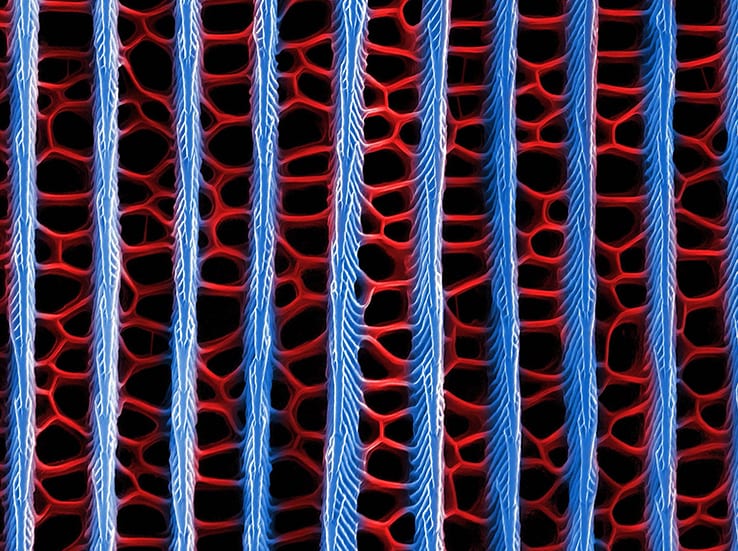 February 23, 2018 – BNC Microscope Zooms in on Butterfly Wings
February 23, 2018 – BNC Microscope Zooms in on Butterfly Wings
Using the BNC’s Zeiss ORION NanoFab Helium Ion Microscope, researchers in the Patel lab produced this image of nanostructures on a black wing scale from an emerald-patched cattleheart butterfly, colorized to highlight ridges in blue and cross ribs in red. The image appeared in a Discover Magazine media gallery. More >
 February 15, 2018 – Landry Named Sloan Research Fellow
February 15, 2018 – Landry Named Sloan Research Fellow
Markita Landry, a Chan Zuckerberg Biohub Investigator, has been named a 2018 Sloan Research Fellow. The Sloan fellowships “honor early-career scholars whose achievements mark them as among the very best scientific minds working today.” Landry is currently designing a modified two-photon microscope to image dopamine sensors, hoping to find a way to assess how psychiatric drugs affect the release and concentration of dopamine in the brain. More >
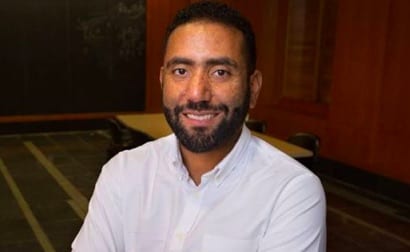 February 3, 2018 – Streets Gets Chemyx Innovation Award
February 3, 2018 – Streets Gets Chemyx Innovation Award
Aaron Streets, Assistant Professor of Bioengineering, is the first recipient of the Chemyx Innovation Award. His laboratory is developing new tools for the study of single cells and is researching new avenues for the study of cellular microfluidics. More >
